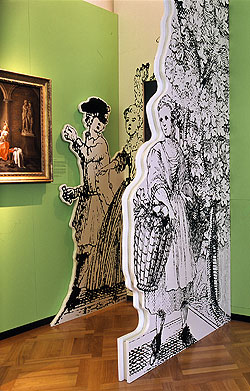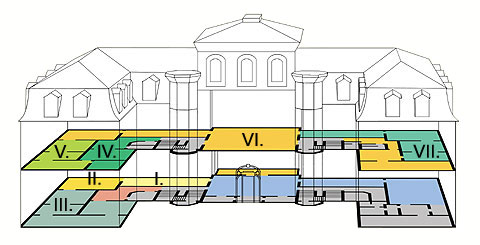Inhalt:
Garden Museum
Concept
The Fantaisie Palace Garden Museum opened by the Bavarian Administration for State-owned Palaces, Gardens and Lakes in July 2000, is the first German museum exclusively devoted to the history of garden design.

The idea behind the museum is not to provide an exhaustive documentation of the history of gardens as part of the history of art and culture. Instead, the contents have been limited to aspects of garden history in the period from the 17th to the 19th centuries that are of interest to the majority of visitors, with a regional focus on South Germany, in particular Bavaria and Franconia. The collection and selection of the exhibits was particularly important in order that the history of garden design could be illustrated by means of original items, presented in relationship to one another. The exhibits are thus deliberately arranged to highlight contrasting aspects of the twenty individual subjects.
The building used for the museum is Fantaisie Palace, which was built from 1762 to 1765 and partially redesigned in 1850. Arranged so as not to detract from architectural features of the interior, twenty aspects of garden design history are shown in twenty of the rooms, with seven overall themes:
-
 Style epochs (from the Middle Ages to the modern age)
Style epochs (from the Middle Ages to the modern age) -
 Design principles (formal and landscape garden design)
Design principles (formal and landscape garden design) -
 Design elements (sculpture, water, buildings)
Design elements (sculpture, water, buildings) -
 The basis of garden design (literature, designers and gardeners, tools)
The basis of garden design (literature, designers and gardeners, tools) -
 Garden plants (flowers, fruit and vegetables, orange trees and palm trees)
Garden plants (flowers, fruit and vegetables, orange trees and palm trees) -
 Fantaisie Palace and Park (history and design, "White Hall" as the original banqueting hall)
Fantaisie Palace and Park (history and design, "White Hall" as the original banqueting hall) -
 Garden use (furniture and ornaments, festivities and games, monastery, farm and bourgeois gardens, public gardens)
Garden use (furniture and ornaments, festivities and games, monastery, farm and bourgeois gardens, public gardens)

Isometric drawing of the palace building showing the overall themes and individual topics of the Garden Museum.
The Fantaisie Palace Garden Museum is however unique because of the way in which the place and the subject form a unit: an exhibition on garden history is linked with an actual historical garden. On the one hand the scope of the exhibition is considerably enlarged by the views of the park from the windows, while on the other, the historical park is the distinctive setting of the palace and hence of the museum building. With its original design elements from three important phases of German garden design (the rococo, the sentimental landscape and the mixed style periods), it confirms what the visitors have seen in the exhibition and above all gives them the opportunity to enjoy and experience to the full a real historical example of garden design. The palace park also shows how plants were used as design elements in the past, from the flowers and leafy plants in the ornamental beds and old varieties of fruit and trellises in the kitchen garden to hedge walls and arbours as "green architecture" in the formal garden section and exotic trees and shrubs planted to provide accents in the landscape areas.
With its outstanding didactic concept and informative documentation, the Fantaisie Palace Garden Museum has now been incorporated into the history text book of Bavaria's Realschulen (a type of secondary school).

Recommendation in the social media
Facebook Twitter Google Plus